
|
|

June 5, 2009
Elmira, Utica and Albany Analog TVs
Here we are in the home stretch, with just a week to go before analog full-power TV in the United States is a thing of the past - and with our keen interest in broadcasting history, we're doing all we can to chronicle what remains of the analog TV infrastructure before it's all gone.
In this week's installment, we take some quick spins past some of the soon-to-be-darkened analog sites of upstate New York, with a promise to present fuller versions (complete with studio tours) once things quiet down, post-transition.
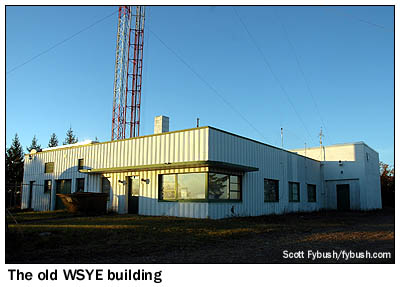 |
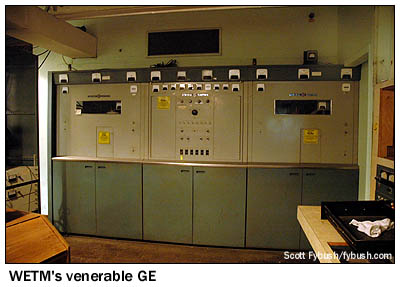 |
The first site on this week's itinerary is in Elmira, 90 miles or so south of Rochester, where much of the market's TV history is contained in a single building on Hawley Hill, just west of downtown. This is the spot where Elmira's oldest surviving TV station, now known as WETM-TV (Channel 18), has operated since its first day on the air back in 1956, and it's been the home of the city's second TV station, WENY-TV (Channel 36), since that station's 1969 debut.
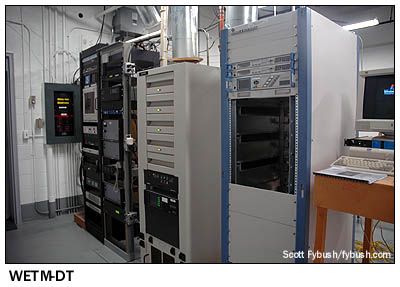 |
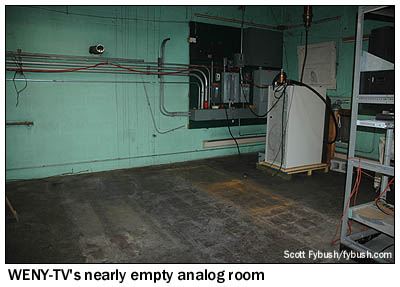 |
 Channel
18 was actually Elmira's second TV station, following on the
heels of a failed venture, WTVE (Channel 24). Like so many small-market
UHF stations, WTVE didn't last long, signing on in 1953 and leaving
the air just a year later after Hurricane Hazel destroyed its
transmitter site on South Mountain. When channel 18 signed on
two years later, it was as a stripped-down operation. Then known
as WSYE-TV, it was a satellite of Syracuse's NBC affiliate, WSYR-TV,
channel 3, with only a bare-bones local newscast inserted into
the programming coming from Syracuse, 90 miles or so to the northeast.
Channel
18 was actually Elmira's second TV station, following on the
heels of a failed venture, WTVE (Channel 24). Like so many small-market
UHF stations, WTVE didn't last long, signing on in 1953 and leaving
the air just a year later after Hurricane Hazel destroyed its
transmitter site on South Mountain. When channel 18 signed on
two years later, it was as a stripped-down operation. Then known
as WSYE-TV, it was a satellite of Syracuse's NBC affiliate, WSYR-TV,
channel 3, with only a bare-bones local newscast inserted into
the programming coming from Syracuse, 90 miles or so to the northeast.
A microwave relay chain brought the WSYR programming through the hills from the channel 3 site at Sentinel Heights south of Syracuse through two interim hops, including one at Connecticut Hill near Ithaca, before arriving here at Hawley Hill.
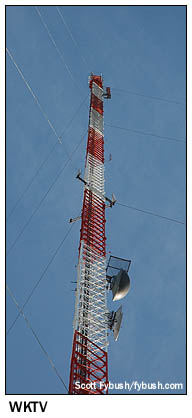 When
Syracuse's WSYR-TV became WSTM in 1980, WSYE became WETM, and
a few years later the Elmira station broke free of its Syracuse
parent, building its own studios in downtown Elmira and taking
on separate ownership. (Ironically, WETM eventually ended up
as part of the Clear Channel/Newport cluster of upstate TV stations,
and today its master control is once again in Syracuse, at the
hub located at channel 9, which - even more irony! - now holds
the WSYR-TV calls.)
When
Syracuse's WSYR-TV became WSTM in 1980, WSYE became WETM, and
a few years later the Elmira station broke free of its Syracuse
parent, building its own studios in downtown Elmira and taking
on separate ownership. (Ironically, WETM eventually ended up
as part of the Clear Channel/Newport cluster of upstate TV stations,
and today its master control is once again in Syracuse, at the
hub located at channel 9, which - even more irony! - now holds
the WSYR-TV calls.)
After WETM built its downtown studios, the Hawley Hill facility remained in use as a transmitter building, with the old offices and studio turning into storage. The old GE transmitter that powered WSYE for many years was actually back in service when we visited in the fall of 2008, since tubes for a new(er) Acrodyne transmitter in the back room had become hard to obtain. WETM-DT was operating with low power on channel 2, pending a flash cut to digital on channel 18 on transition day.
As for WENY-TV, the ABC affiliate will be saying farewell to Hawley Hill come transition day, since it's building its permanent DTV channel 36 facility at a different site near Corning. Even last fall, its analog transmitter room, in an annex that was built on to the channel 18 building back in 1969, was nearly empty; a fire had destroyed its full-power analog transmitter, leaving just a low-power transmitter back in the corner keeping WENY-TV's over-the-air signal chugging along until the deadline.
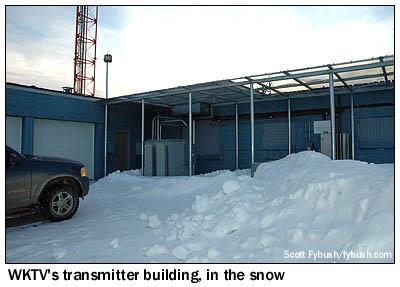 From
Elmira, we hopscotch north and east to another small market,
Utica, and another trip back in TV history.
From
Elmira, we hopscotch north and east to another small market,
Utica, and another trip back in TV history.
WKTV was one of the first TV stations in the region when it signed on back in 1949, and its studios (which we'll see in a later Tower Site of the Week installment) still remain at the same site they occupied back then, on Smith Hill north of Utica.
A decade later - on January 1, 1959, to be precise - WKTV moved from its original channel 13 allotment, with transmitter at the Smith Hill studio location, to a new dial position, channel 2. Spacing restrictions to channel 2 in Buffalo required the new WKTV site to be located considerably east of Utica - and so WKTV now transmits from a site in Middleville, NY, north of Herkimer.
The 1036-foot tower and the helical antenna that crowns it are original, and the GE transmitter (built in nearby Syracuse!) from 1959 sits in pieces in the garage. When we stopped by in February 2009, the main transmitter room once filled by the GE transmitter was relatively empty, with an RCA "G-line" analog transmitter in one corner keeping analog humming and an Axcera transmitter on the other side of the room for WKTV-DT (Channel 29).
Unlike the other stations shown here, WKTV silenced its analog signal on the original deadline date of February 17, so this site is already digital-only, and analog is a thing of the past.
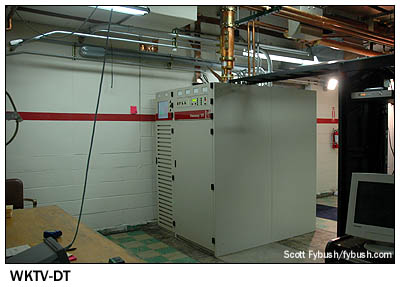 |
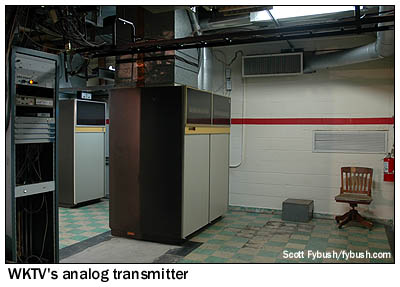 |
WKTV's move to channel 2 back in 1959 was part of a large-scale realignment of TV allocations across upstate New York that freed channel 13 to be reused in two places - in Rochester for a third VHF allottment that became WOKR(TV) in 1962, and in Albany for the move of what was then WTRI(TV) from channel 35 to the VHF band.
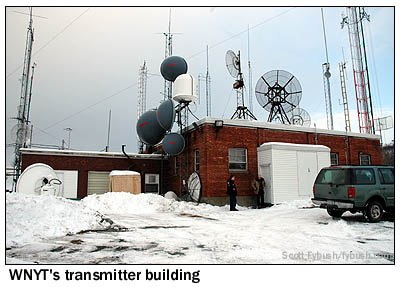 |
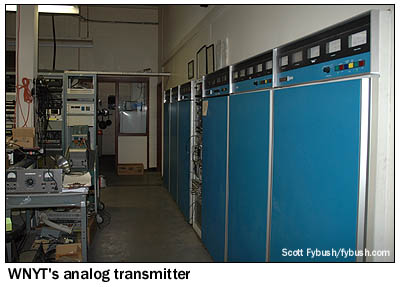 |
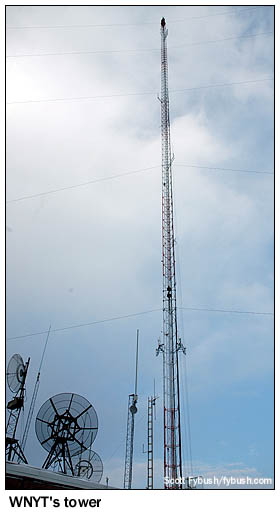
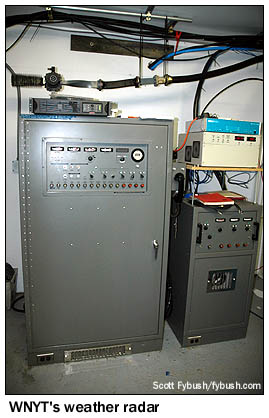 The site that WTRI
called home from the beginning is still in use today by channel
13, which has changed calls over the years from WAST-TV (for
Albany, Schenectady and Troy) to WNYT, and
has changed affiliations from ABC to CBS to NBC.
The site that WTRI
called home from the beginning is still in use today by channel
13, which has changed calls over the years from WAST-TV (for
Albany, Schenectady and Troy) to WNYT, and
has changed affiliations from ABC to CBS to NBC.
We finally made it up to this site on Bald Hill, northeast of Troy, during that snowy February 2009 swing across upstate New York and New England, and we learned some things we hadn't known: for one, that this was the original WTRI studio location when the station signed on back in 1955. (Within just a few years, it had relocated to the former warehouse in Menands, north of Albany, that WNYT still calls home.)
Back in the garage area that was once the WTRI studio, we had the chance to peek at WNYT's weather radar, a converted military unit. We also had our first look at a site that will become increasingly common at broadcast transmitter locations: the Rohde and Schwartz UHF transmitter that's used by Qualcomm for its MediaFLO service, operating on the former TV channel 55 to provide video to mobile devices.
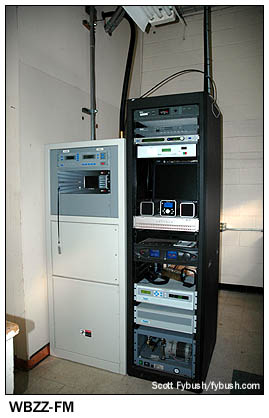 Back
in the main transmitter room, dominated by the Harris transmitter
along one wall for analog channel 13, there's an FM transmitter
tucked into one corner: this is WBZZ (105.7 Malta), Albany Broadcasting's
latest move-in, which had formerly been up in the Glens Falls
market as Queensbury-licensed WNYQ.
Back
in the main transmitter room, dominated by the Harris transmitter
along one wall for analog channel 13, there's an FM transmitter
tucked into one corner: this is WBZZ (105.7 Malta), Albany Broadcasting's
latest move-in, which had formerly been up in the Glens Falls
market as Queensbury-licensed WNYQ.
 WNYT-DT
operates on channel 12 - but not from Bald Hill.
WNYT-DT
operates on channel 12 - but not from Bald Hill.
While channel 13 had to be on Bald Hill due to spacing requirements with channel 13 in Rochester and WNET (Channel 13) down in New York City, WNYT was able to put its digital transmitter at the same location as most of the rest of the Albany market's TV stations, in the Helderberg Mountains southwest of Albany. We'd already profiled the joint DTV transmission facility built by all the Albany stations in a previous Site of the Week installment, but we hadn't made it inside the WNYT room until this trip. Once we did, we saw a Harris Platinum transmitter (which will be augmented, post-transition, by another amplifier cabinet coming from sister station WHEC-TV here in Rochester) - and another Qualcomm MediaFLO installation, too.
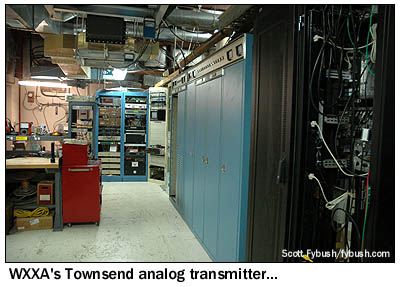 |
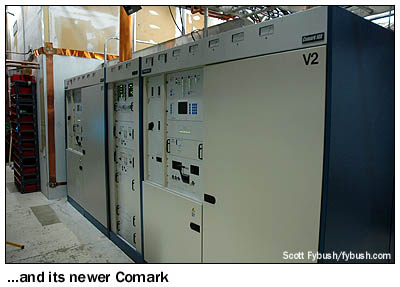 |
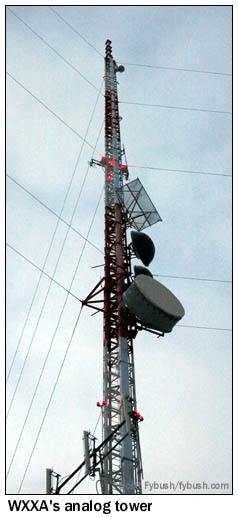
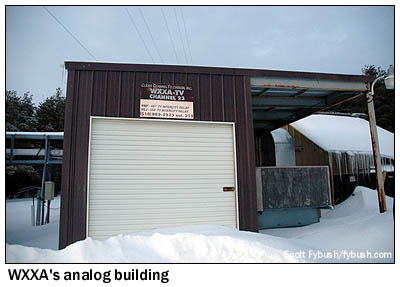 Our visit to the
Helderbergs site took us inside another building in addition
to the DTV master faciilty: Fox affiliate WXXA (Channel 23) has
operated in analog since its 1982 debut from a tower at the southern
end of the tower farm up here, and we'd never made it inside
until chief engineer Sarge Cathrall brought us up here near sunset
on this snowy February afternoon.
Our visit to the
Helderbergs site took us inside another building in addition
to the DTV master faciilty: Fox affiliate WXXA (Channel 23) has
operated in analog since its 1982 debut from a tower at the southern
end of the tower farm up here, and we'd never made it inside
until chief engineer Sarge Cathrall brought us up here near sunset
on this snowy February afternoon.
This site is on its second antenna, after suffering a massive antenna failure a few years back, and it's on its second transmitter, too - the Townsend that greets visitors to the transmitter room, original to 1982, has been supplanted by a newer Comark that's tucked in behind the Townsend.
Like WNYT's Bald Hill site, this facility will fall mostly silent come June 12, since WXXA-DT operates from the master DTV site down the hill. Bald Hill will remain active for WNYT's weather radar, ENG receive, and as a leased site for WBZZ, MediaFLO and other tenants; WXXA's site will also remain active, at least for now, as an ENG receive site.
And as we cross the one-week line to the sunset of analog TV, we're pleased to have been able to share a few more pieces of the analog TV legacy with you. In the months to come, we'll revisit some of these stations with more extensive looks at their studio facilities and histories...stay tuned!
- Previous Site of the Week: Boston's WHDH, WLVI and WCVB
- Next Week: Analogs Turn Off (part I)
- Site of the Week INDEX!
- How can you help support Site of the Week? Click here!
- Submit your suggestions for a future Site of the Week!
